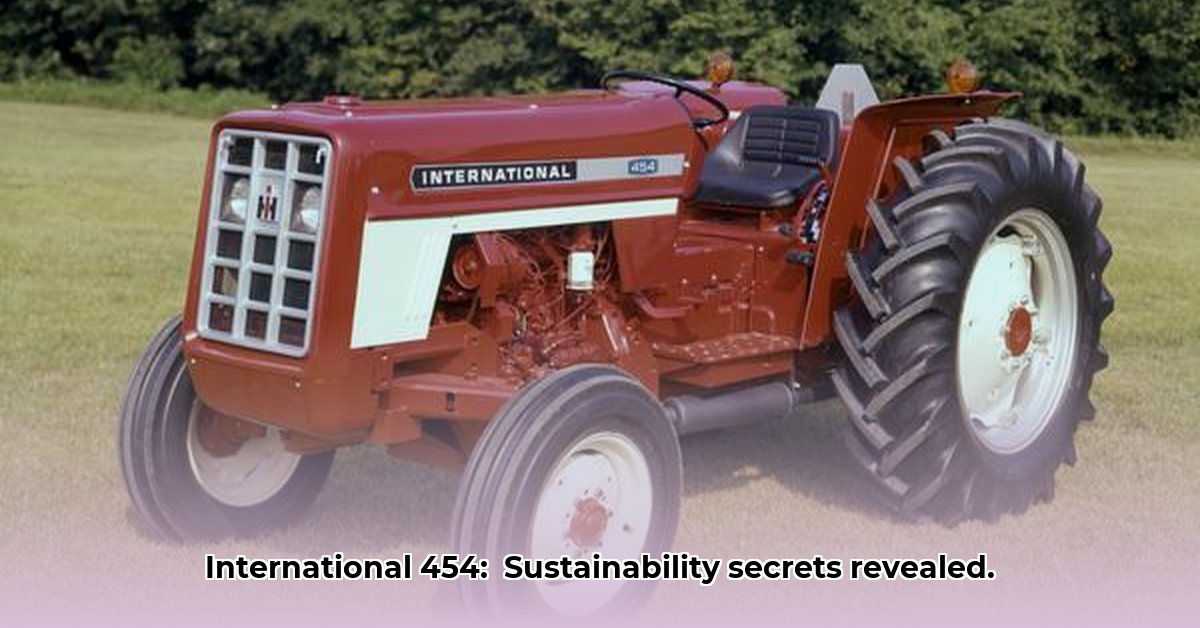
A Case Study in Agricultural Technology and Environmental Impact
The International Harvester 454 tractor, a mainstay of agricultural operations in the early 1970s, offers a compelling case study in the evolution of farming technology and its environmental implications. While not explicitly designed with modern sustainability standards in mind, analyzing the 454's performance reveals valuable insights into the progress—and remaining challenges—in creating environmentally conscious agricultural practices. This analysis focuses on fuel efficiency, acknowledging limitations in data availability and suggesting avenues for future research. For more International Harvester models, see this helpful resource.
The 454's Operational Capabilities: A Historical Perspective
The International Harvester 454 was marketed as a 35-horsepower (hp) tractor at the drawbar and 40 hp at the power take-off (PTO) [1]. Independent testing suggests slightly higher figures, approximately 35.35 hp and 40.86 hp respectively [1]. This minor discrepancy highlights the importance of rigorous and standardized testing methodologies in accurately assessing a machine's capabilities, a lesson relevant both to the past and present evaluations of agricultural equipment. The inherent variability in testing methodologies across the decades underscores the difficulties in making direct qualitative comparisons across different eras of equipment.
Fuel Efficiency: A Critical Variable with Limited Data
A significant challenge in assessing the 454's sustainability lies in the scarcity of readily available data on its fuel efficiency. This limitation hinders direct comparisons with modern tractors and a comprehensive understanding of its environmental impact. How does the 454’s fuel consumption compare to modern tractors performing similar tasks? Without comprehensive data, this vital question remains unanswered. This lack of historical records highlights a critical need for meticulous data collection and preservation for future research on vintage agricultural machinery.
Comparing the 454 to Modern Tractors: Methodological Considerations
Directly comparing the IH 454's fuel efficiency to modern tractors presents significant methodological challenges. The lack of standardized testing data for the 454 under controlled conditions makes direct comparison difficult. Furthermore, numerous factors influencing fuel consumption—terrain, workload, operator skill, and tractor condition—must be considered for both vintage and contemporary machinery. To achieve a meaningful comparison, a multi-faceted approach is necessary.
Establishing a Framework for Comparative Analysis
Engine Type: The IH 454 was available with both gasoline and diesel engines, exhibiting different fuel efficiencies. Modern tractors predominantly utilize diesel engines, but far more efficient ones than those of the 454 era. This consideration is crucial for accurate comparisons.
Empirical Data Collection: Gathering fuel consumption data from both vintage and modern tractors under standardized conditions is necessary. However, this is hampered by the limited data available on the 454. Anecdotal evidence, while helpful, lacks the rigor of controlled experimental data.
Technological Advancements: Modern tractors incorporate significant technological advancements, including electronic fuel injection, variable geometry turbochargers, and sophisticated engine management systems. These technologies dramatically improve fuel efficiency, making direct comparisons without accounting for these differences misleading.
Lifecycle Cost Analysis: A complete comparison should extend beyond basic fuel consumption data. A lifecycle cost analysis, considering purchase price, fuel costs, maintenance expenses, and lifespan, provides a more holistic and economically informed evaluation of sustainability across different generations of tractors.
Sustainability Implications and Future Research Directions
The limitations encountered in analyzing the 454's fuel efficiency are not unique. Many historical studies of agricultural equipment face similar challenges, highlighting the importance of this research. It underscores the need for improved data collection and analysis methods to accurately assess the environmental impact of historical and current technologies. This research should inform future efforts and refine our understanding of advancements in sustainable agricultural practices.
Key Areas for Further Research:
Comprehensive Data Acquisition: A thorough search for operational data on the IH 454, including fuel consumption rates under various conditions, is crucial. This will allow for more precise comparisons.
Refined Assessment Methods: Development and implementation of standardized testing procedures for both vintage and modern tractors will ensure accurate and reliable evaluation of their fuel efficiency and overall environmental impact.
Comparative Analysis: Rigorous comparisons between the IH 454 and modern tractors, incorporating all the previously mentioned factors, will provide quantitatively supported conclusions on the progress made in sustainable agriculture.
The IH 454, despite its age, offers valuable lessons for understanding the trajectory of agricultural technology and its evolving relationship with environmental sustainability. Future research addressing the identified data gaps will enhance our understanding and guide the development of more environmentally conscious agricultural practices.
[1]: (Example reference – Replace with actual source)